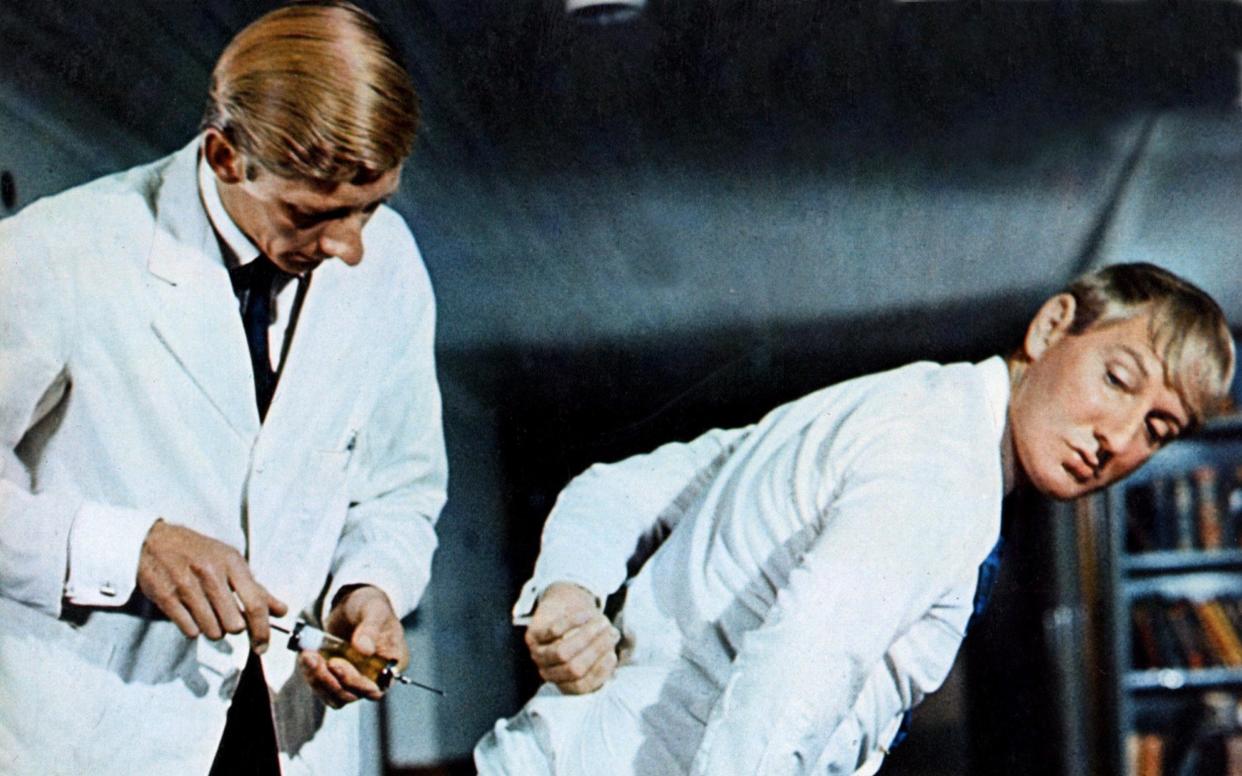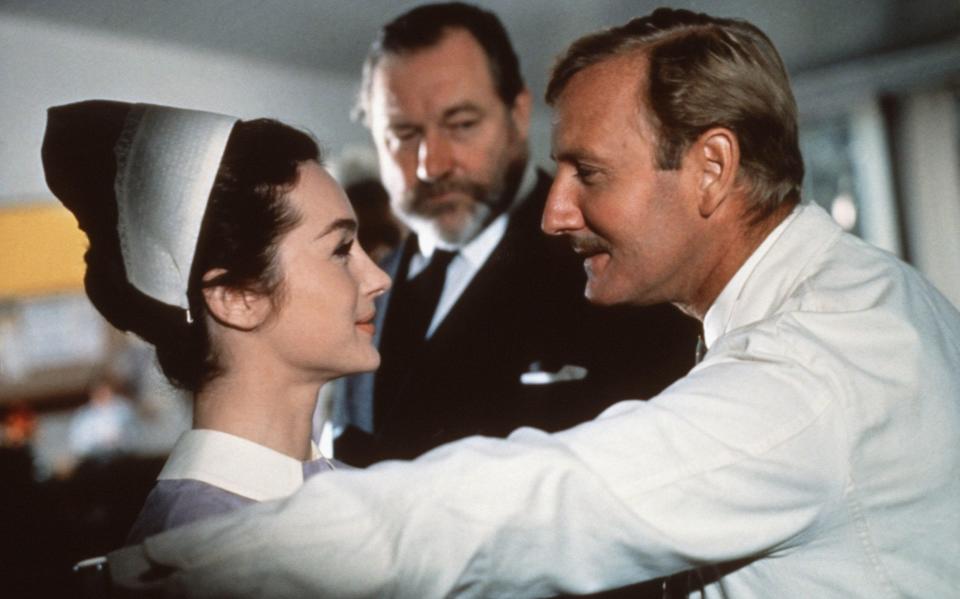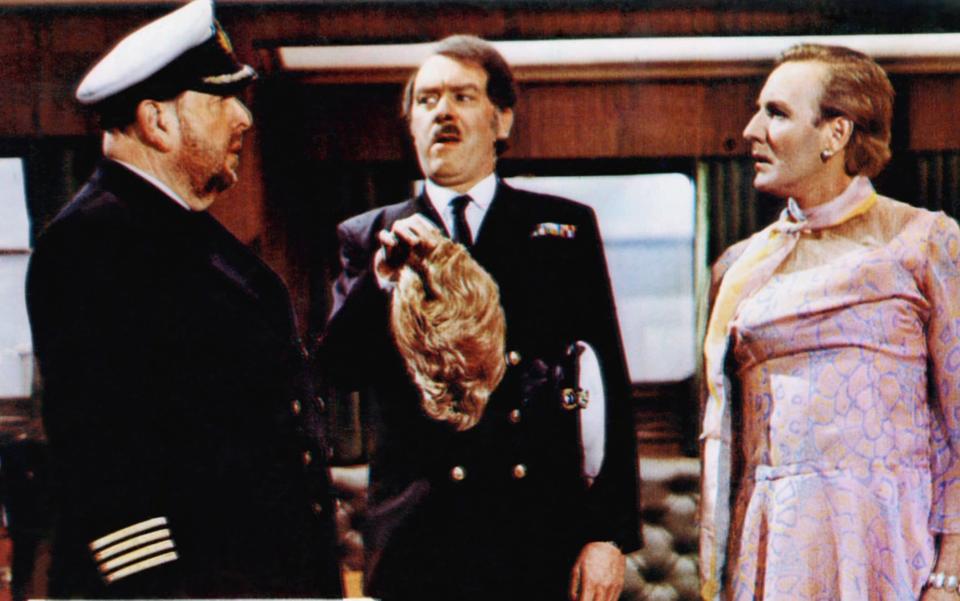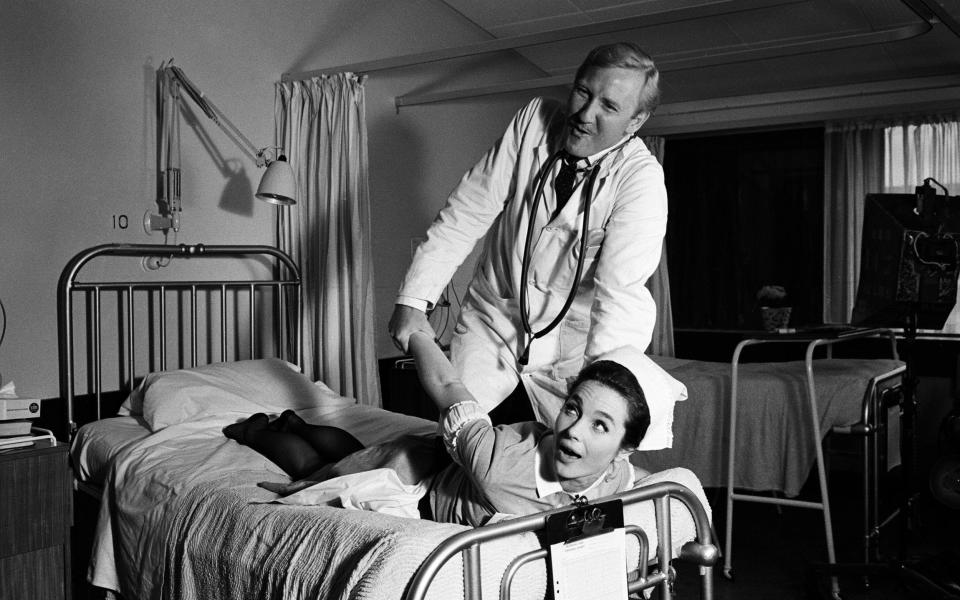‘Well, hello!’: why the sex-mad, satirical Doctor in Clover was the making of Leslie Phillips

- Oops!Something went wrong.Please try again later.
- Oops!Something went wrong.Please try again later.
- Oops!Something went wrong.Please try again later.
- Oops!Something went wrong.Please try again later.
- Oops!Something went wrong.Please try again later.
- Oops!Something went wrong.Please try again later.
Amidst the many characters that the great Leslie Phillips, who has died at the age of 98, should be celebrated for is none other than Dr Gaston Grimsdyke: medical practitioner, preening roué and all-round cad. Dr Grimsdyke appears in the sixth of the Doctor films, Doctor in Clover, and establishes himself almost immediately as the kind of man who one would usually strive to avoid in intimate situations.
We learn that he has been fired from his previous role as a medical officer in a men’s prison (misbehaviour with the Governor’s daughter) and that he has wound up at St Swithin’s Hospital, ostensibly in an attempt to turn over a new leaf and make a difference to the lives of the patients, but in fact Dr Grimsdyke’s primary interest lies in attempting to seduce the nurses, much to the weary contempt of his superior, James Robertson Justice’s Sir Lancelot Spratt.
Doctor in Clover was made in 1966, after the success of such Carry On films as Carry On Cleo, Carry On Spying and Carry On Cowboy, and so it is little surprise that the kind of humour that it displays – from a script by Jack Davies, who had written Those Magnificent Men In Their Flying Machines the previous year, and directed by Ralph Thomas, brother of regular Carry On director Gerald – is bawdier and more innuendo-based than the earlier films in the Doctor series.
Yet this shift away from light-hearted medical-based humour (with a touch of satire towards the newly formed NHS, if one cared to look hard enough) towards something much more akin to the misadventures of Williams, James, Hawtrey et ali was a reflection of what the public wanted, and also the way in which the author of the Doctor novels, Richard Gordon, had shifted his own writing: what had begun as light-hearted semi-autobiography inexorably turned into trouser-dropping farce. It may not have been subtle, but it suited the persona that Phillips was developing by the mid-Sixties, of the dashing rake, down to a “t”.
Gordon was a pseudonym for the doctor Gordon Ostlere, who practiced medicine until 1952, when, after the success of his debut novel Doctor in the House, he was able to abandon a life as an anaesthetist and ship’s surgeon in favour of a career writing.
He was a serious figure in the medical profession, writing such technical manuals as Anaesthetics for Medical Students and Anaesthetics and the Patient, but soon became disillusioned with the stressful life that he was leading, and had an epiphany while on board a ship travelling to Australia. Believing that the crew were all healthy and likely to remain so, he was faced either with the opportunity of drinking himself senseless, or writing down a lightly fictionalised account of his exploits. Ostlere wisely chose the latter.
The eventual publication of Doctor in the House featured “Richard Gordon” as its protagonist, and revolved around the exploits of a good-hearted but naïve medical student who is embroiled in various shenanigans at St Swithin’s Hospital, mainly revolving around drinking too much, going on ill-fated dates and having a rivalry with another medical school that will eventually be resolved by a rugby match, all under the watchful eye of the dictatorial Spratt.
It was an enormous success, prefiguring Kingsley Amis’s not-dissimilar (although considerably darker) Lucky Jim in several regards, and the all-powerful Rank organisation acquired the rights to the novel. But there was initial concern that Gordon’s episodic structure lacked a central storyline; the producer Betty E Box, a regular collaborator with Thomas, stated: “I think I know how to do it. I take my four students through three or four years of medical training and make that the story.”
Although Gordon was co-credited with the screenplay, it was Nicholas Phipps, a veteran comedian and revue writer, who managed to turn the book into a compelling, amusing story, which was then duly filmed in 1954. It starred Dirk Bogarde as the Gordon character (renamed Simon Sparrow for the picture), Robertson Justice and, in the role of Richard Grimsdyke – presumably a relation of Gaston – Kenneth More. It was unusual casting because none of the lead actors were regarded as comedians, especially Bogarde, but Rank would only allow the filmmakers to use their regular contract players.

It turned out to be a blessing in disguise. Thomas later said: “They didn't really have any funny actors to work with; they were all straight actors. Dirk Bogarde had never played a funny line in his life. Not one of them ever did anything because they wanted to make it funny. They played it within a very strict, tight limit of believability. Dirk was able to do that, he got away with it and it stopped him from being just another bright, good looking leading man and made him a star.”
The film was an enormous success at the box office, and was the most popular picture of the year; it recouped its costs within weeks, and was the first purely British film to make a million pounds’ profit by 1956. Its success was largely down to the way in which the medical profession, which had previously been treated with near-reverence by filmmakers, was portrayed both affectionately and irreverently, with once all-powerful doctors and surgeons brought down to earth. It also gave British comic cinema one of its most amusingly iconic exchanges: when Spratt, mid-operation, shouts at Sparrow “What’s the bleeding time?”, the medical student, distracted by the nurse next to him, suavely responds “10 past 10, sir.”
The two subsequent films in the series, Doctor at Sea and Doctor at Large, offered more of the same, to highly profitable effect. But Bogarde feared that he might be typecast forever in the role and left the series before the fourth film, Doctor in Love, which instead featured Michael Craig as Dr Richard Hare: a stand-in for Bogarde’s Sparrow by any other name.

Yet the film was most notable for the first appearance of Phillips, albeit not as Grimsdyke but as the cheerfully suave Dr Tony Burke – the joke about Burke and Hare may have been lost on many audiences – whose penchant for greeting attractive women with the most absurdly elongated “Hello!” imaginable became one of the actor’s signature catchphrases. While Craig was poor in the lead (one critic dismissed him as “not only no Dirk Bogarde, but also no comedian”), and the film was much heavier on innuendo and risqué humour than the others had been, it managed to showcase Phillips’s abilities as a light comic admirably.
Somewhat unbelievably, Bogarde – who by now had showed his credentials as a serious actor in such films as Victim and Song Without End – was enticed back for the fifth film in the series, Doctor in Distress, released a few months before his iconic performance as the Machiavellian butler Hugo Barrett in The Servant, for which he won a BAFTA. Unsurprisingly, Bogarde then left the role of Sparrow behind for good, which allowed Phillips first to essay the role of Grimsdyke in Doctor in Clover, and then to reprise the character of Burke in the final Doctor film, Doctor in Trouble. Here, Phillips finds himself accidentally stowing away on an ocean liner after his pursuit of the miniskirt-clad fashion model Ophelia O’Brien, with the usual farcical consequences.
By now, the series was struggling to keep up both with changing public tastes and attitudes. Despite an attempt to appeal to a new audience with more swearing and semi-nudity, there was a general consensus that the Doctor films had become an anachronism, not least because such pictures as Robert Altman’s M*A*S*H, which was released the same year, offered far blacker and more subversive views of the medical profession in extremis.

It also did not help that Robertson Justice, for so long the mainstay of the series, had suffered a cerebral haemorrhage shortly before filming. He returned for a brief scene, but the role was essentially taken over by Robert Morley, playing Spratt’s brother Captain George. Box commented: “Situations which would have been hilarious with James were just mildly amusing with Morley, and the whole point of the piece was lost.”
Although the Doctor series continued in Gordon’s writing well into the Eighties, and later spawned an Anglo-Australian spin-off television show, it never attained the longevity (or, at times, notoriety) of the Carry On series, in which Phillips also appeared, and so now is largely neglected by comparison with its ruder, cruder cousin.
Yet at its best, it offered a mixture of wit and satirical humour that was almost totally alien to the Carry On films, and enabled Phillips to perfect the persona of the well-spoken and rakish man-about-town whose suave exterior was nonetheless undone by (usually self-created) circumstances that he would use throughout the rest of his career. If it had not been for the Doctor films, we may never have seen the great comic actor at his louchest, and that would have been the most crushing of disappointments. Wouldn’t it, ladies?

